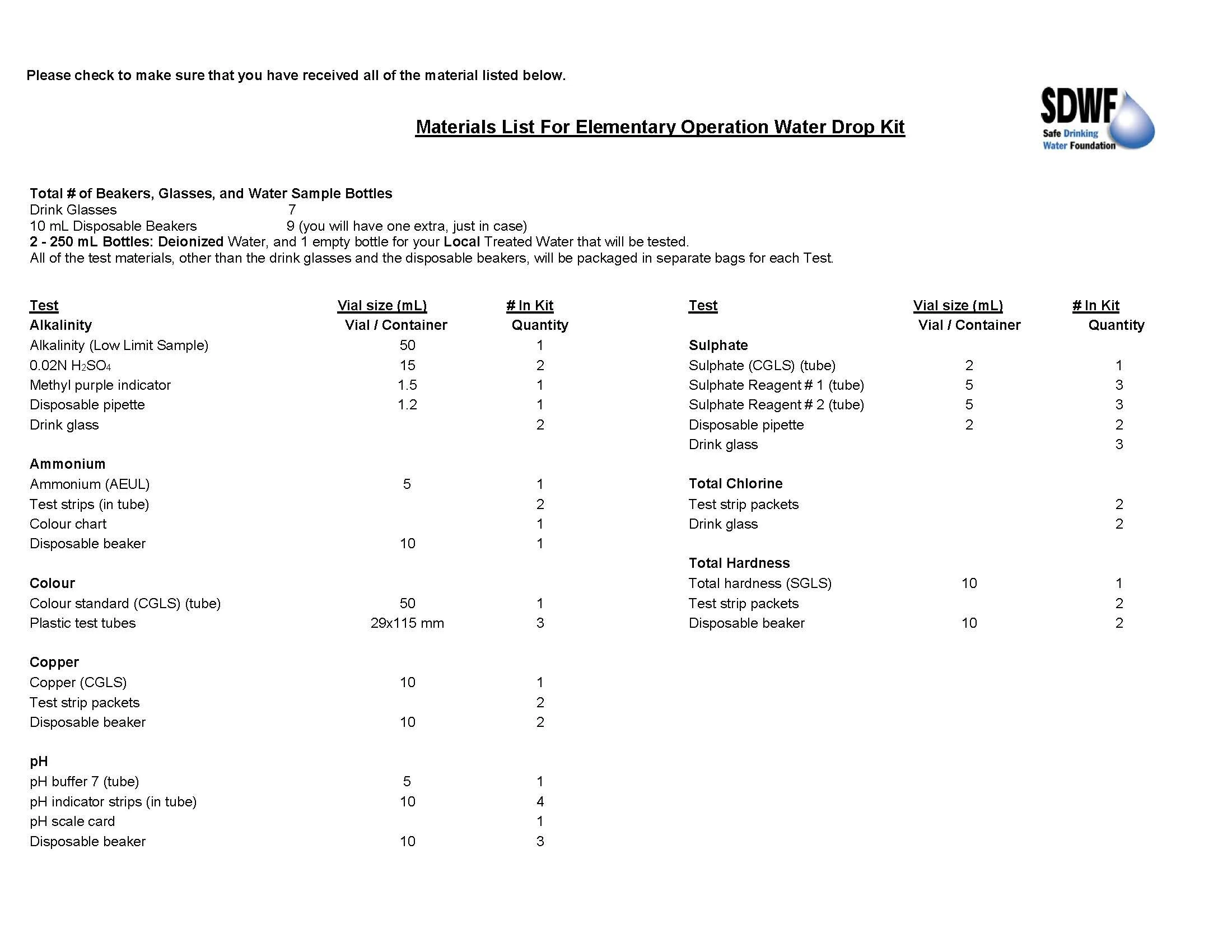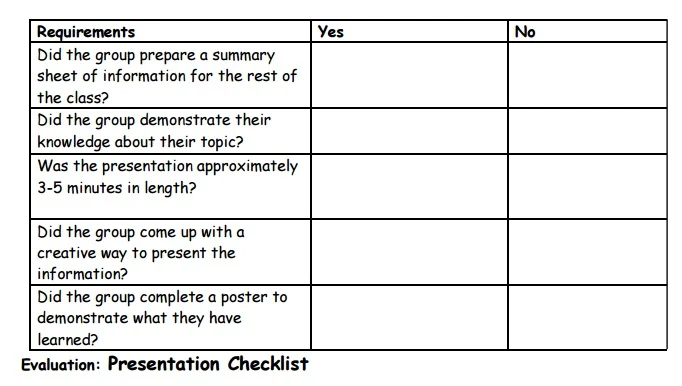Subject: Science, Biology, Chemistry, Health
Topic: Testing the water we drink!
Time Frame: Approximately 40 minutes
Objectives: There are 8 tests to be run in this kit, teachers will demonstrate 2 different tests, and these tests are: Alkalinity and Sulphate. The students can do the other 6 tests with a minimal amount of help, these tests are: Ammonia, pH, Colour, Copper, Total Chlorine, and Total Hardness. Provided with the Operation Water Drop kit are supplies to run tests on the local drinking water source, and on a Canadian Drinking Water Guideline sample. The guideline sample is for quality control purposes (was the test performed properly?). This will also be a reference to see what a sample would look like if it meets the Canadian Drinking Water Guideline, students are then expected to gather their own water samples for the Local Treated Water. They will then be able to compare their own community drinking water to the Canadian Drinking Water Guideline.
Methodology: The tests will include: precipitation, colourimetric, visual, bacteriological, and test strips. All procedures, instructions, and reference material are available online for easy reference and reporting. It is suggested you print out the individual test instructions for quick reference and follow instructions closely. It is also recommended that you print the materials list to ensure you have all materials.
Materials: Each Operation Water Drop Test Kit contains 8 test supply bags with all requirements for testing your drinking water, and the Canadian Drinking Water Guideline Limit sample; for each analyte tested all supplies required are packaged in one bag for your convenience. You will find a list of all materials sent in the OWD kit; please cross-reference your list with material received to ensure you have all of the material required.
A Note About Disposal: After the testing has been completed, everything can be poured down the tap as even the arsenic test is within limits of safety. However, if you are concerned and are able to do so, you could take the solutions to a local waste disposal facility or university chemistry department.
Additional materials:
Although the OWD kit is complete, there are a few things that will be needed to ensure analyses are performed with ease and accuracy.
Each group should have:
A permanent marker for test tube labeling
Masking tape for labeling pipettes
A 25 mL and a 50 mL measuring device (preferably a graduated cylinder)
A test tube rack
Coke and bleach or other acidic and basic liquids for the pH tests
Space Requirements: Students should be in a room with sufficient bench or desk space to work comfortably in small groups to conduct their tests.
Directions:
The Teacher and students will be testing water for the following parameters:
Approximate Time for all tests to be completed is 40 minutes.
1. Copper
2. Alkalinity
3. Sulphate
4. Ammonium
5. Colour
6. pH
7. Total Chlorine
8. Total Hardness
Teacher Demonstration: Alkalinity, and Sulphate.
Student Tests: 6 groups with each group doing a different test (Colour, Copper, Ammonium, pH, Total Chlorine, and Total Hardness) on the water sample and the Canadian Guideline Limit Sample.
The teacher should do the demonstration on the two tests (15 minutes), then split the class up, the classroom should be divided into 6 separate groups; each group will be running tests on their own drinking water plus a Canadian Guideline Limit Sample (or in the case of ammonia, a European Union Limit Sample) that is supplied for all analytes.
It cannot be overstated how important it is to be clean and careful while doing all of these tests. Please remember that although the tests are designed to be safe for students to use, whenever working with any amount of chemicals lab safety precautions must be taken into consideration. For best safety practices, please ensure that your students wear lab coats, goggles and gloves when handling the kit materials and samples.
Results:
After the tests have all been completed, the teacher should lead a discussion on the results that were found.
The class and teacher are also encouraged to complete and submit the online Program Evaluation Form on the Safe Drinking Water Foundation website. The success of the Operation Water Drop program depends on this feedback and reporting. The Safe Drinking Water Foundation thanks everybody in advance for their cooperation in the reporting of their results.
Possible Presentation Questions/Topics:
Does it concern you that Canada has no national regulations (just guidelines) for drinking water?
Do you feel rural (including Aboriginal and non-Aboriginal) people should be concerned about their drinking water?
Is your water treatment plant modernized?
Are your water treatment plant operators certified?
Are you comfortable/satisfied that your community water is safe?
For more questions and possible solutions please refer to the fact sheets that are attached to the methods.
Resources:
Visit the Safe Drinking Water Foundation website www.safewater.org to learn more about issues affecting safe drinking water. Once at www.safewater.org go to Resources and then Fact Sheets to find more information about several of the tests that you have or will run.
You will find links to many Educational Fact Sheets and various articles published pertaining to the different analyses which students conduct as part of Operation Water Drop.
For more information on health risks and possible contributors of all chemicals you can go to the following website: http://www.lenntech.com/who-eu-water-standards.htm you will also find the drinking water standards for the World Health Organization, and the European Union at this site.



